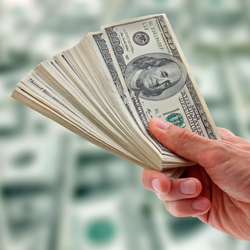exhibiting 101 |

|
 |
 Candy Adams,
Candy Adams,
CTSM, CME,
CEM, CMP, CMM,
is an independent exhibit-management
consultant, trainer, speaker, writer, and an Exhibitor conference
faculty member.
CandyAdams
@BoothMom.com
|
| |
 here have only been a handful of times in my career when I felt truly helpless. One of those times came when I was negotiating a contract with a number of major hotel chains for my employer's first-time international distributor conference. The hotel sales staff seemed to speak its own special language: They asked me all kinds of strange questions, such as how many gallons of coffee I'd want at breaks and how much room I'd need for audiovisual equipment in my meeting rooms. As an event-planning rookie, I had to relinquish a bit of control and rely on those staffers to help me estimate what I would need. here have only been a handful of times in my career when I felt truly helpless. One of those times came when I was negotiating a contract with a number of major hotel chains for my employer's first-time international distributor conference. The hotel sales staff seemed to speak its own special language: They asked me all kinds of strange questions, such as how many gallons of coffee I'd want at breaks and how much room I'd need for audiovisual equipment in my meeting rooms. As an event-planning rookie, I had to relinquish a bit of control and rely on those staffers to help me estimate what I would need.
After that initial experience, I figured there had to be someplace to learn the ins and outs of event and meeting planning. Luckily, a hotel salesperson directed me to a 40-hour program for event planners hosted by a local university. During that week, I learned that managing all the details of events was a cinch once you understood the guidelines, standards, and rules of thumb. And I took good notes.
The formulas, guidelines, and advice that follow are meeting-industry estimates based on experience as opposed to scientific calculations. Some of these facts I learned during preparations for my Certified Meeting Professional (CMP) exam sponsored by the Convention Industry Council, and others I've learned from the University of Hard Knocks.
Space Configurations
The amount of space your event needs will depend on the type of function you're hosting and corresponding room layout, e.g., theater, classroom, banquet, or reception.
Theater - Plan for 8 square feet per person if no AV presentation is involved. If AV will be used, increase the space to 10 square feet per person. Theater setups allow you to pack the most people into the smallest space, and are fine if attendees won't be taking a lot of notes and sessions are short.
Classroom - Allot 12 square feet per person if you want three people per 6-foot table, or 18 square feet for two people per 6-foot table, allowing 44 inches between each row of tables. For classroom configurations with AV, plan a minimum of 15 square feet per person. Classroom setups are better for serious training sessions or when people need room to take notes.
Banquet and Reception - Banquets and most receptions with a bar (or multiple bars) and standard buffet tables require 10 to 12 square feet per person. Banquet rounds are best for in-depth, small-group discussions, and they allow for quick room reset for food functions.
Food and Beverage Needs
Having the right mix of cold and hot beverages is key to keeping attendees happy and hydrated. Take these averages into account when placing your beverage order.
Coffee, Tea, and Soda - Average consumption of beverages in the morning will be roughly 65 percent hot (coffee and tea) and 35 percent cold (juice, iced tea, and soda). In the afternoon, beverage consumption will average about 65 percent cold and 35 percent hot. Coffee and hot water for tea are purchased by the gallon, which equals about 128 ounces and produces roughly 20 6-ounce cups.
Snacks - Buy cookies, pastries, and brownies by the dozen rather than per person as it's cheaper to buy in bulk. Or, if it's something that's individually wrapped, like granola bars or yogurt, buy on consumption.
Alcohol Estimations
While you certainly don't have to serve alcohol at your event, it's quite common to have at least wine and beer on tap - especially at evening affairs. Consider these rules of thumb to help keep your attendees satiated, but not sloshed.
Wine - A 750 milliliter (mL) bottle of wine contains 25.4 ounces. For each bottle of wine, you'll get about four-and-a-half 6-ounce servings, or five 5-ounce servings.
Beer - A keg of beer holds 1,984 ounces, which equals about 165 12-ounce servings.
Liquor - A standard bottle of 80-proof distilled spirits (such as vodka, rum, gin, or tequila) holds 750 mL, or 25.4 ounces, and pours approximately 17, 1.5-ounce shots. If your bartender is using 1-ounce pours (known as a "short shot" or "pony shot"), a bottle will yield up to 25 drinks. To keep costs down (and drinks conservative), instruct your bartenders to use a measured shot glass rather than free pouring. Also negotiate to purchase liquor by the bottle rather than by the drink. It will be cheaper in the long run to buy the liquor for 20 to 25 drinks in one bottle rather than paying per drink - just like buying a keg of beer is cheaper per glass than buying individual bottles or cans. Agree up front with the catering manager on a system for auditing the used and unused bottles of liquor before and after the event.
In addition to these serving rules of thumb, also consider the following stats regarding alcohol consumption, which typically varies depending on the environment in which it's served.
Cash Bar - Average consumption
for a one-hour party with a cash bar (where guests are purchasing their own drinks) is 1.5 drinks per person. While a cash bar might seem like a more cost-effective option for event planners since attendees are purchasing their own drinks, keep in mind that you are still responsible for the cost of the bar setup, any necessary labor, and the bartender (and possibly a bar-back helper).
Open Bar - Conventional wisdom will tell you that free drinks flow more, well, freely. And you're right. Average alcohol consumption at a one-hour "open" or "hosted" bar is 2 to 2.5 drinks per person.
Reception - If you sponsor a post-conference reception with a cash bar, 50 percent of the crowd will stay for the reception, averaging about 1.5 drinks per person. If it's a hosted bar at a cocktail hour, 80 percent of the conference crowd will stay for the reception, consuming an average of 2.25 drinks per person in the first hour and 1.5 drinks in the second hour. Here again, you'll want to purchase sodas and beer on a consumption-only basis (rather than a per-person basis), paying only for what is used.
Dinner - If you're hosting a dinner, serve three bottles of wine (two white and one red) for each table of eight people, as one bottle of wine yields about five glasses.
Below-the-Line Costs
It's important to understand the below-the-line costs of your event, beyond the basic charges. You may be surprised to find up to an additional one-third of your bill comprises administrative fees, service charges, and mandatory gratuities, plus local and state taxes.
Gratuities - A gratuity can be a tip or mandatory percentage of the basic charges. Depending on local tax laws, a gratuity may or may not be taxable. The way in which gratuity is distributed can be specified in your event contract with the venue. A rule of thumb for event-gratuity payments is 1.5 percent to 2 percent of the total event bill. You can have this amount added to your master account and distributed to preselected banquet and bar staff, or you can distribute it yourself to make sure the appropriate people receive it.
Tips - A tip is a small sum of money given voluntarily and directly to someone above and beyond a standard charge (generally for performing a service or task). Tips range from 15 percent for average service to 20 percent or more for exemplary service, and are awarded to waitstaff, housekeeping staff, and other service personnel at your discretion.
Administrative Fees - Sometimes called a service charge or service fee, an administrative fee is an automatic and mandatory amount added to food and beverage charges by the service provider. It is typically calculated as a percentage of the total, and is usually used to defray the cost of labor and equipment. Generally speaking, these charges fall somewhere in the 18-percent to 23-percent range.
Note that sometimes, these administrative fees, taxes, and surcharges are not included in your quote. So ask if menus are available with "inclusive pricing," or pricing that includes both taxes and gratuity. If you see a "++" after the cost on a menu, it means "plus tax and plus gratuity." Also, ask what foods, beverages, and services are taxable and at what percentage. For example, some states and cities charge tax on alcoholic beverages, but not on food or nonalcoholic beverages. You'll want to know the figure on which your gratuity or service charge is based, as well.
Possible Perks
When negotiating perks with a venue, be prepared to answer questions about previous meetings you've planned, anticipated attendance, projected attendance at meal and beverage functions, the estimated number of room nights you'll require, and your space requirements for meeting rooms. Your leverage depends on all of those things, as well as the type of facility you're dealing with and the dates of your event.
|
Calculating Event-Registration Fees
To determine your event's registration fee (RF), divide your fixed costs (FC) by the number of anticipated attendees (AA) and add your variable costs per person (VC/P).
Example: If the fixed cost for your event is $200,000, the variable cost per person is $500, and you anticipate 1,000 attendees, the registration fee should be $700.
The formula is:
(FC/AA) + (VC/P) = RF
(200,000 / 1,000) + $500 = $700
|
If you're planning your event when everyone else wants to be at that particular venue, it's "high season," which means higher prices. On the other hand, if your event occurs during a time of year when hurricanes or blizzards are common, it might be "off season," which translates to better overall pricing. Bottom line, if your event fills a "hole" in the venue's schedule, it will be more flexible on other pricing.
Regardless of when your event takes place, you can usually negotiate one complimentary room for each 35 to 50 cumulative room nights during your event. Stipulate in your contract that the total number of rooms used is cumulative through your entire event, not calculated daily - and that it includes your guests' early arrivals and late departures - and that all rooms used by your group, regardless of how they were booked (i.e., through the Internet or a travel agent) count toward your total room count. You can also request staffers' rooms and speakers' rooms at a lower rate (or with upgrades). Other negotiable perks include resort and health-facility use, complimentary cocktail parties, parking waivers, free Internet or business-center use, complimentary airport transportation, and reductions or waivers for the cost of parking, meeting rooms, or exhibit space.
By having these formulas and rules of thumb to reference, you'll be at the head of the class when it comes to planning your next hospitality event. After all, knowledge is power.e
|
|
|





 here have only been a handful of times in my career when I felt truly helpless. One of those times came when I was negotiating a contract with a number of major hotel chains for my employer's first-time international distributor conference. The hotel sales staff seemed to speak its own special language: They asked me all kinds of strange questions, such as how many gallons of coffee I'd want at breaks and how much room I'd need for audiovisual equipment in my meeting rooms. As an event-planning rookie, I had to relinquish a bit of control and rely on those staffers to help me estimate what I would need.
here have only been a handful of times in my career when I felt truly helpless. One of those times came when I was negotiating a contract with a number of major hotel chains for my employer's first-time international distributor conference. The hotel sales staff seemed to speak its own special language: They asked me all kinds of strange questions, such as how many gallons of coffee I'd want at breaks and how much room I'd need for audiovisual equipment in my meeting rooms. As an event-planning rookie, I had to relinquish a bit of control and rely on those staffers to help me estimate what I would need. 


